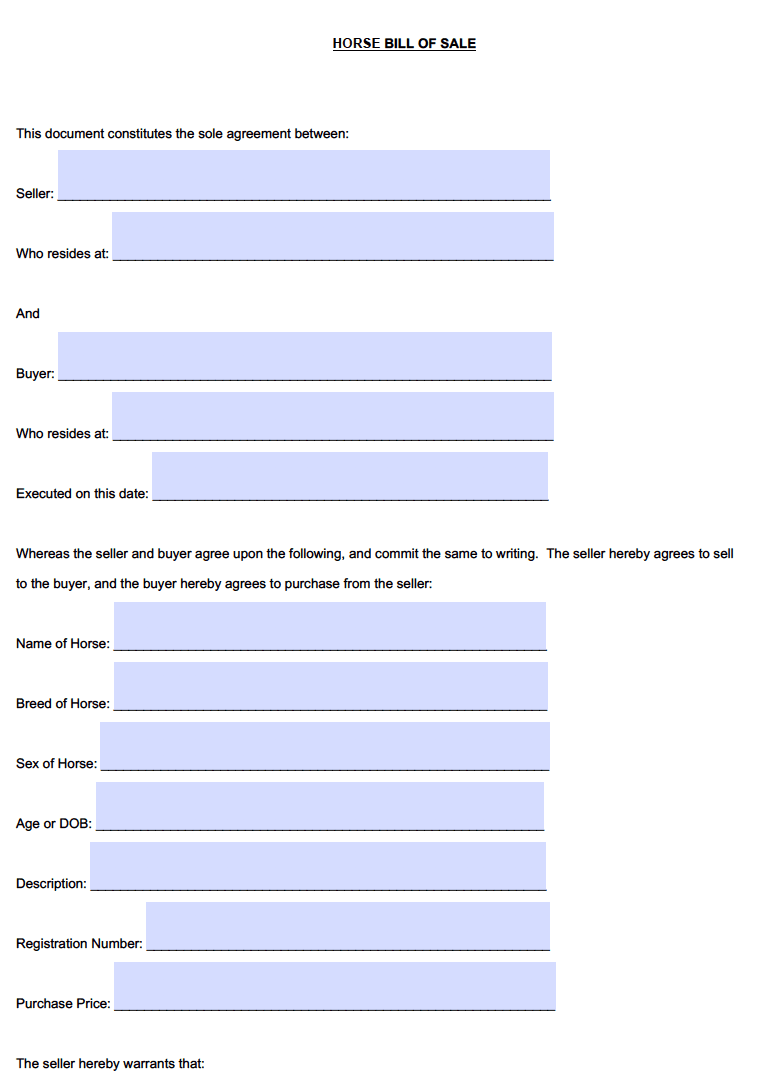Do I Need a Bill of Sale?
Whether you are selling or buying a horse, executing a bill of sale is a smart decision. It stipulates where, when, and how the transaction will transpire. For the buyer, it confirms that they are now the new owner and purchased the animal for a specified price (it will also ease the process of registering the animal). For the seller, it releases any liability attached to the horse. Each party should keep a copy for their records.
How to Sell a Horse
Selling a horse can seem intimidating if you don’t know where to start. Listed below are some steps that can be taken to help guide you through the process of selling your animal.
Step 1 – Determine Value
First things first, you are going to have to determine what the animal is worth. Pricing a horse can be complicated, but considering all the factors involved, there is no definitive method. Such factors include:
- Height and Weight
- How old is the animal?
- Is it male or female?
- What is the color of its coat?
- What is the bloodline?
- Temperament
- Is it trained?
- Does it perform a specific skill?
- Is it in good health?
Once you have considered all these elements, you can estimate the price by comparing your horse to similar horses that have been sold or are still for sale in the marketplace.
Step 2 – Marketing Your Horse
Now that you have decided to sell your horse and have a price in mind, it’s time to advertise it to the public. How can you make people aware that your horse is available for purchase? Well, several avenues can be taken to promote your horse. One way to get the word across is to buy an ad in a local newspaper or magazine. Another way is to attend a horse show and network with fellow horse enthusiasts, and by doing so, you may find someone looking to buy.
In today’s age, the internet is a great place to expose potential buyers to an item you want to sell. Some popular websites that are specifically geared towards selling and buying horses are:
Some more general websites that are not specific to the sale of horses would be:
- CraigsList.org – Find your way to the “for sale” area and post under the “farm+garden” section.
- FaceBook.com – Advertise your horse on Facebook, especially if you are friends with other horse enthusiasts.
Step 3 – Creating a Post
To advertise online, you must create a “post.” When creating your post, you will want to include some essential things.
- Pictures & Videos – Buyers want to see accurate images and videos of the horse for sale. Be sure to groom the animal before the shoot and use a quality camera to capture photos of the animal. Take many pictures and select the best ones to catch the viewer’s attention. A video is another way to display the horse’s abilities (if the advertising site allows videos). Take a short video of the horse exhibiting any training or skills it may have.
- General Information – On most classified ad websites, you will be prompted to give the essential details to entice visitors to click on your ad. This typically includes:
- Posting Title – For the post’s title, insert something you think will catch a potential buyer’s attention.
- Price – Insert the number you came up with when calculating the horse’s value.
- Location – Where is the animal located?
- Contact Information – Provide contact information that will allow interested parties to get in touch with you. You can list your name, phone number, and email address.
- Description – Provide a detailed description of the horse. Some things you may want to include are:
- Age
- Weight
- Height
- Gender
- Breed
- Training
- Behavior
- Medical History
Step 4 – Meeting with the Buyer
You will want to schedule a showing once you find someone interested in buying the horse. Consult with the interested party on where and when the meeting will occur. When you meet, the buyer typically wants to look over the horse and potentially give it a test run. If the buyer is satisfied with the animal, it will be time to negotiate the terms of the sale. They may try to offer a lower number than the original asking price, and if so, you may accept or return with a counteroffer. Once you have agreed on a price, form of payment, and the overall exchange, you will want to start the paperwork. Be sure to collect all the documentation concerning the horse (registration, vet records, DNA results, etc.) and deliver them to the new owner. Each party should have a copy of the bill of sale to be completed and signed. Once the bill of sale has been completed and a payment has occurred, the horse may be transferred to its new owner, and the transaction is finalized.

